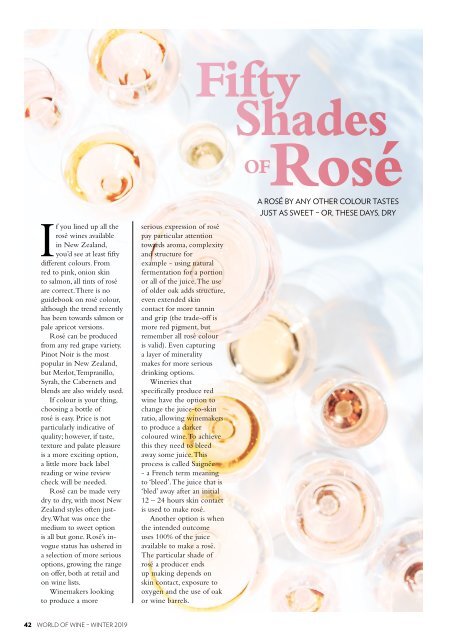Create successful ePaper yourself
Turn your PDF publications into a flip-book with our unique Google optimized e-Paper software.
Fifty<br />
Shades<br />
OFRosé<br />
If you lined up all the<br />
rosé wines available<br />
in New Zealand,<br />
you’d see at least fifty<br />
different colours. From<br />
red to pink, onion skin<br />
to salmon, all tints of rosé<br />
are correct. There is no<br />
guidebook on rosé colour,<br />
although the trend recently<br />
has been towards salmon or<br />
pale apricot versions.<br />
Rosé can be produced<br />
from any red grape variety.<br />
Pinot Noir is the most<br />
popular in New Zealand,<br />
but Merlot, Tempranillo,<br />
Syrah, the Cabernets and<br />
blends are also widely used.<br />
If colour is your thing,<br />
choosing a bottle of<br />
rosé is easy. Price is not<br />
particularly indicative of<br />
quality; however, if taste,<br />
texture and palate pleasure<br />
is a more exciting option,<br />
a little more back label<br />
reading or wine review<br />
check will be needed.<br />
Rosé can be made very<br />
dry to dry, with most New<br />
Zealand styles often justdry.<br />
What was once the<br />
medium to sweet option<br />
is all but gone. Rosé’s invogue<br />
status has ushered in<br />
a selection of more serious<br />
options, growing the range<br />
on offer, both at retail and<br />
on wine lists.<br />
<strong>Wine</strong>makers looking<br />
to produce a more<br />
serious expression of rosé<br />
pay particular attention<br />
towards aroma, complexity<br />
and structure for<br />
example - using natural<br />
fermentation for a portion<br />
or all of the juice. The use<br />
of older oak adds structure,<br />
even extended skin<br />
contact for more tannin<br />
and grip (the trade-off is<br />
more red pigment, but<br />
remember all rosé colour<br />
is valid). Even capturing<br />
a layer of minerality<br />
makes for more serious<br />
drinking options.<br />
<strong>Wine</strong>ries that<br />
specifically produce red<br />
wine have the option to<br />
change the juice-to-skin<br />
ratio, allowing winemakers<br />
to produce a darker<br />
coloured wine. To achieve<br />
this they need to bleed<br />
away some juice. This<br />
process is called Saignée<br />
- a French term meaning<br />
to ‘bleed’. The juice that is<br />
‘bled’ away after an initial<br />
12 – 24 hours skin contact<br />
is used to make rosé.<br />
Another option is when<br />
the intended outcome<br />
uses 100% of the juice<br />
available to make a rosé.<br />
The particular shade of<br />
rosé a producer ends<br />
up making depends on<br />
skin contact, exposure to<br />
oxygen and the use of oak<br />
or wine barrels.<br />
A ROSÉ BY ANY OTHER COLOUR TASTES<br />
JUST AS SWEET – OR, THESE DAYS, DRY<br />
42 WORLD OF WINE – WINTER <strong>2019</strong>

















